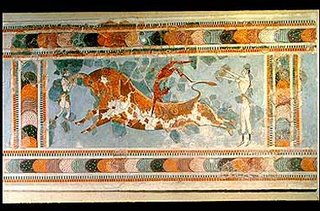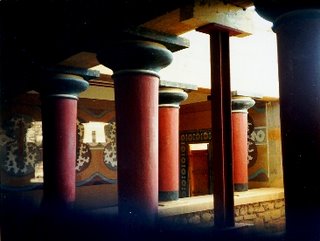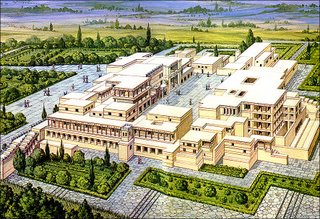
 About four-thousand years ago when great buildings were erected they were mainly either funerary monoliths or fortresses. Such was the nature of the world four-thousand years ago.
About four-thousand years ago when great buildings were erected they were mainly either funerary monoliths or fortresses. Such was the nature of the world four-thousand years ago.Back then, war and death and disaster were still largely the order of the day and the focus of much of daily life, and life for the most part was seen as simply a small part of the more important journey taking place after death. (Think for example of the Great Pyramids and the Egyptian death cults, and the Sumerian and Chinese fortresses of this period. Such was the architectural expression seen under the sun.)
 Not in Crete however, under the legendary King Minos.
Not in Crete however, under the legendary King Minos.Minos' fortress walls, it was said, were the sea around Crete, allowing the palace to lose the defensive aspect that so many buildings retained until relatively recent history. And the sense of life of the Minoan civilisation was said, for the most part, to be exuberantly life-affirming. The result of these two 'happy accidents' can be seen in these reconstructions of Minos' Palace at Knossos (pronounced with a hard 'k'), arguably the first extant example of a building embracing this earth and this life instead of the putative 'next' one.
 Rather than spend time, effort and energy building stone on stone just for glory in the next life, the Minoans it seems preferred to focus on the here and now; on joy and pleasure in this one.
Rather than spend time, effort and energy building stone on stone just for glory in the next life, the Minoans it seems preferred to focus on the here and now; on joy and pleasure in this one. Based on reconstructions seen here of what Knossos might have been like, we can see that the building reflected this enlightened attitude. It was ground-hugging, opening up to light and air and to gardens and delights -- in one direction a theatre, in another downhill to gardens, in another a path to the caravanserai and down to the port whose trade kept the Minoans rich.
Based on reconstructions seen here of what Knossos might have been like, we can see that the building reflected this enlightened attitude. It was ground-hugging, opening up to light and air and to gardens and delights -- in one direction a theatre, in another downhill to gardens, in another a path to the caravanserai and down to the port whose trade kept the Minoans rich.Inside was a humble throne room opening directly off the main courtyard, and around that were shaded courtyards with running water, gentle breezes, delightful chambers full of walls with delightful frescoes, and in them men and women happy to show off the bodies and the athleticism of which they were clearly so proud.
And all this -- all this 'earthly paradise' had to offer -- all of four-thousand years ago. How 'bout that! You can see why the legend of Atlantis is sometimes ascribed to those early Minoans, perhaps the first flowering on this earth of a truly life-affirming civilisation, and a link to the beginnings of the Hellenistic civilisation from which we still reap the benefits today.
RELATED: Art, Architecture, History, Knossos
2 comments:
apparantly it had flush toilets too.
Frankly I wonder about these reveries about a palace without walls. It is so out of synch with the times and the following 1000 years - including similarly secure island locations - until the invention of high velocity explosive projectiles made city walls all but useless. I wonder if our view of Knossos is an over romantic one based on what we want to see rather than what is actually deducible from the ruins. call me cynical...
Beutiful architecture, considering it was built around 4,000 years. I wondered if that city in those days had a city council to impose rates. Did people have properties, renting or live like gypsies. If they had property rights, then on what conditions? Never cut their your own tree(s) in their land or something similar. It would be interesting to know, the type of society around 4000 years back.
Post a Comment